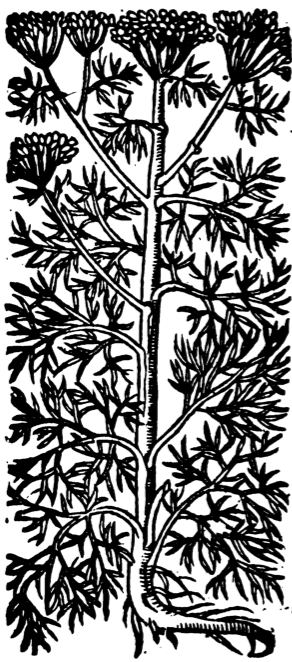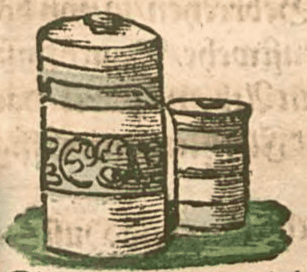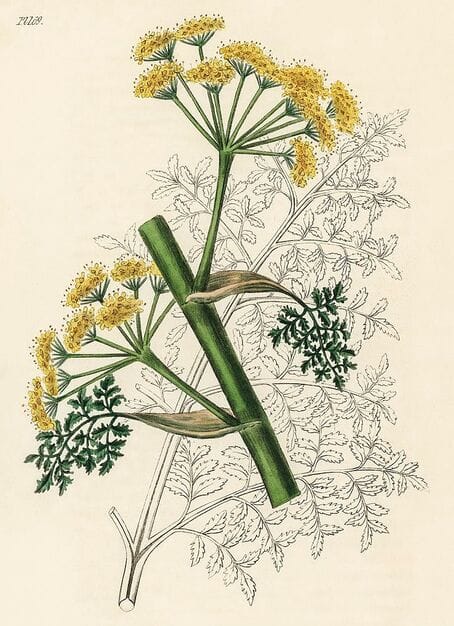Sagapenum, SagapenSerapinumSakbinaj (Unani) |

|
 Krauter Buch und kunstliche Conterfeyungen, 1703
Krauter Buch und kunstliche Conterfeyungen, 1703 |
 Sagapen in containers for export
Sagapen in containers for exportKrauterbuch, Lonitzer, 1578 |
 Curtis’s Botanical Magazine, 1819
Curtis’s Botanical Magazine, 1819 |
 Ferula persica
Ferula persica |
Botanical name:
Ferula persica (syn. Peucedanum persicum)
Parts used:
Gum
“The best varieties of Sagapen are those which are relatively thicker and cleaner with a red interior and white exterior”. (Avicenna)
Temperature & Taste:
Hot, dry. Pungent
“Hot in the Third and Dry in the Second degree”. (Avicenna)
Classifications:
4j. NERVINE
Uses:
1. Clears Cold-Phlegm and Damp:
-clears Phlegm, Water and Damp from the Lungs, Stomach, Uterus, Head, Nerves and Joints
-‘clears thick matter from the Lungs’ (Dioscorides)
-‘useful in Chest pain, Pleurisy and Chronic Cough’ (Avicenna)
-Edema, Fluid Retention, stoppage of Urine, Stones
-obstructions of the Liver, Stomach or Spleen from Qi and Phlegm stagnation
2. Clears Wind-Phlegm, Stops Spasms:
-Cramps, Convulsions, Epilepsy, Headache, Paralysis, Numbness
-arthralgia; weakness of the Nerves and Joints from Cold-Phlegm and Damp
-“useful in Paralysis, as welI as dislocation of muscles and ligaments“. (Avicenna)
-“purges out harmful matter accumulated in the Hips” and “cold and malignant Arthralgia”. (Avicenna)
-“Headache caused by Cold and gases [Wind]”. (Avicenna)
3. Warms the Uterus, Moves the Qi and Blood, Promotes Menstruation:
-Amenorrhea, Dysmenorrhea, Uterine pain
-hardness and tumors of the Uterus
-smelled with vinegar relieves “suffocation of the Uterus” (Dioscorides)
-“When taken with honey wine it proves to be an Emmenagogue” (Avicenna)
-stimulates Sexual Desire (Avicenna)
4. Clears Wind, Resists Poison:
-Intermittent Fever (Dioscorides, Avicenna)
-bites of wild animals, taken with wine (Dioscorides)
-insect bites and fatal poisons, taken with wine (Avicenna)
5. Externally:
-“one of the best drugs used for treating Cataract”. (Avicenna)
-applied with Vinegar to cure a stye in the Eyelid
-draws thorns and splinters out
-the fumes when burnt were used to revive the Epileptic
-in plasters for Pleurisy
-applied to Arthritic pains
-applied to all hardness and hard tumors
Preparation:
Dissolve in Warm water, Wine, or Vinegar, then strain, and evaporate.
Dose:
Usually used in compounds
Powder: 250–1500mg (up to 3 grams had been given)
Correctives:
1. Ginger
2. Cinnamon
3. Mastic
Substitute:
Galbanum. Avicenna said Sagapen is stronger than Galbanum.
Main Combinations:
1. To purge Phlegm and resolve Wind:
i. Sagapen and Rue
ii. Sagapen with Aloe, Bdellium, Agaric
2. Edema:
i. and Back pain, Sagapen, Aloes, Bdellium, Gum Arabic, Agaric (equal parts) (Syrian ‘Book of Medicine‘, Budge, 1913)
ii. and Sagapen, Gum Ammoniac, Aloe, Bdellium, Myrrh, Agaric, Euphorbium (Syrian ‘Book of Medicine‘, Budge, 1913)
3. Arthritis and Rheumatism, Sagapen with Colchicum, Aloe, Yellow Myrobalan, Turbith, Bdellium, Colocynth, Rue seed, Celery seed, Saffron (as in Pills of Colchicum Greater of Mesue)
4. Paralysis, Hemiplegia from Wind-Damp, Sagapen, Agaric, Colocynth pulp, Euphorbium, Bdellium (3 parts each), Aloes (2 parts), form pills with Cabbage juice. Dose: 1 scruple–half dram. (Syrian ‘Book of Medicine‘, Budge, 1913)
5. Paralysis, Back pain, Arthritis from Damp, Sagapen, Bdellium, Gum Ammoniac, Aloes, Opopanax, Rue seed, Euphorbium, Colocynth (Syrian ‘Book of Medicine‘, Budge, 1913)
6. All types of Cough, Sagapen, Gentian, Myrrh, White Pepper, Laurel berries (Syrian ‘Book of Medicine‘, Budge, 1913)
7. Difficult or labored breathing, take Sagapen with Rue. (Avicenna)
8. Obstructions of the Liver, Stomach or Spleen, Sagapen, Rhubarb, Bdellium, Gum Ammoniac, Spikenard, Polypody, Aloe (Syrian ‘Book of Medicine‘, Budge, 1913)
9. Obstructions and pain of the Liver, Spleen and Stomach, and to promote free urine, Sagapen, Myrrh, Bdellium, Gum Ammoniac, Frankincense, Aloe, Cinnamon, Saffron, Spikenard, Pepper, Cumin (Syrian ‘Book of Medicine‘, Budge, 1913)
10. To promote Menstruation:
i. Sagapen with Honey wine (Avicenna)
ii. Sagapen with Myrrh, Madder, Rue, Cumin, Asafetida (as in Troches of Myrrh)
11. Plaster to soften hardness, Sagapen, Gum Ammoniac, Bdellium, Opopanax, Asafetida, Aloes, Fenugreek, Figs, mixed with vinegar (Syrian ‘Book of Medicine‘, Budge, 1913)
Major Formulas:
Foetid Pills (Mesue)
Pills of Euphorbium (Mesue)
Pills of Rhubarb (Greater) (Pil. de Raved Sceni) (Mesue)
Pills of Colchicum Greater (Mesue)
Pills of Sagapen
Pills of Opopanax (De morbus internis curandis)
Pills for Apoplexy (Arnold de Villa Nova)
Pills to Aggregate Greater (Mesue)
Troches of Myrrh (Rhasis)
Troches of Gums
Electuary of Gums (Zenon)
Electuary of Bayberries (Electuarium de Baccis Lauri)
Electuary of Bayberries (Zacharia)
Indian Electuary (Unani)
Plaster for Hard Tumors of the Uterus
Cautions:
1. Avoid in Pregnancy
2. It irritates the stomach of susceptible people, so should be corrected as described above.
3. Not used in Yin deficiency
Main Preparations used:
Purified Sagapen
|
‘The history of this drug is involved in obscurity, and up to tho present time its botanical source is unknown. From tho examination of portions of the plant found in parcels of the drug received in Bombay, it would appear to be the produce of a Ferula of much the same habit as that producing galbanum. Sagapenum was known to the Greeks, and through them the early Arabic writers probably became acquainted with its medicinal properties. I see no reason to suppose that the ancient Hindus knew the drug, although Kundel is in some books given as the Sanskrit and Hindi name for it. The author of the Makhzan-el-Adwiya gives a sufficiently accurate description of Sagbinaj, and tells us that it is obtained from the district of Mah, near Ispahan. Persian brokers in Bombay inform me that the drug |
brought to this market is collected in the country between Shiraz and Kirman. It is necessary to remark that Persian Sagapenum is distinctly different from what is known as Levant Sagapenum. Mahometan physicians consider Sagapenum to be attenuant and resolvent; when combined with purgatives it is thought to exert its resolvent power upon every part of the system, removing noxious humours; they also value it as an anthelmintic and emmenagogue. For a full account of the diseases in which it is prescribed, I must refer the reader to the Makhzan-el-Adwiya, article Sagbinaj. A sagapenum pill is often prescribed in flatulent dyspepsia; it contains equal parts of Aloes, Sagapenum, Bdellium and Agaric. Two to three dirhems are to be taken with warm water. (Vegetable Materia Medica of Western India, Dymock, 1885) |
–Phytochemistry and pharmacology of Ferula persica Boiss.: A review
ANTIBACTERIAL
–Phytochemistry and pharmacology of Ferula persica Boiss.: A review
ANTI-FUNGAL
–Identification of Antifungal Compounds from Ferula persica. var. persica.
ANTI-INFLAMMATORY
–Phytochemistry and pharmacology of Ferula persica Boiss.: A review
NEUROPATHIC PAIN
–Phytochemistry and pharmacology of Ferula persica Boiss.: A review
CANCER
–Farnesiferol A from Ferula persica and galbanic acid from Ferula szowitsiana inhibit P-glycoprotein-mediated rhodamine efflux in breast cancer cell lines.
–Two matrix metalloproteinases inhibitors from Ferula persica var. persica.
–Phytochemistry and pharmacology of Ferula persica Boiss.: A review
REVERSAL OF MULTI-DRUG RESISTANT CANCER
–Phytochemistry and pharmacology of Ferula persica Boiss.: A review
WOUNDS
–Stereological and molecular studies on the effects of Ferula persica extract on wound healing in rats.
